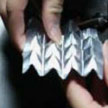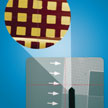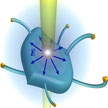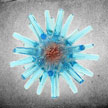Showing Spotlights 1305 - 1312 of 2875 in category All (newest first):
 Biological barriers - the skin, mucosal membranes, the blood-brain barrier and cell/nuclear membranes - seriously limit the delivery of drugs into the desired sites within the body, resulting in a low delivery efficacy, poor therapeutic efficacy, and high cost. Nanomedicine researchers have developed numerous biological, chemical, and physical strategies to overcome these barriers. This article highlights recent advanced physical approaches for transdermal and intracellular delivery.
Biological barriers - the skin, mucosal membranes, the blood-brain barrier and cell/nuclear membranes - seriously limit the delivery of drugs into the desired sites within the body, resulting in a low delivery efficacy, poor therapeutic efficacy, and high cost. Nanomedicine researchers have developed numerous biological, chemical, and physical strategies to overcome these barriers. This article highlights recent advanced physical approaches for transdermal and intracellular delivery.
Feb 13th, 2014
 Researchers have developed a low-cost generic batch process using a state-of-the-art CMOS process to transform conventional silicon electronics into flexible and transparent electronics while retaining its high-performance, ultra-large-scale-integration density and cost. This process relies on standard and cheap silicon (100) wafer and microfabrication techniques, which allows to fabricate high performing devices. Furthermore, it allows the recyclability of the wafer to produce several substrates with devices, making it economically attractive.
Researchers have developed a low-cost generic batch process using a state-of-the-art CMOS process to transform conventional silicon electronics into flexible and transparent electronics while retaining its high-performance, ultra-large-scale-integration density and cost. This process relies on standard and cheap silicon (100) wafer and microfabrication techniques, which allows to fabricate high performing devices. Furthermore, it allows the recyclability of the wafer to produce several substrates with devices, making it economically attractive.
Feb 11th, 2014
 An artificial brain building program has created a process of circuit evolution similar to the human brain in an organic molecular layer. The research team has now finalized their human brain model and introduced the concept of a new class of computer which does not use any circuit or logic gate. The kind of CMOS based integrated chip that forms the core of existing supercomputers will not be used in this kind of computer. The team uses the term brain jelly to describe their purely organic computing architecture.
An artificial brain building program has created a process of circuit evolution similar to the human brain in an organic molecular layer. The research team has now finalized their human brain model and introduced the concept of a new class of computer which does not use any circuit or logic gate. The kind of CMOS based integrated chip that forms the core of existing supercomputers will not be used in this kind of computer. The team uses the term brain jelly to describe their purely organic computing architecture.
Feb 10th, 2014
 In order to fabricate entirely flexible electronic devices, the components that power them - such as batteries - not only need to be fully flexible as well but they have to be compatible with commercially available manufacturing technologies. This would require achieving a high degree of deformability without using elastomeric materials. Researchers have now demonstrated the fabrication of a highly deformable lithium-ion battery using standard electrodes and commercially standard packaging technologies.
In order to fabricate entirely flexible electronic devices, the components that power them - such as batteries - not only need to be fully flexible as well but they have to be compatible with commercially available manufacturing technologies. This would require achieving a high degree of deformability without using elastomeric materials. Researchers have now demonstrated the fabrication of a highly deformable lithium-ion battery using standard electrodes and commercially standard packaging technologies.
Feb 7th, 2014
 Surface metrology and characterization is ever more critical for overall product performance in wide ranging applications across the semi-conductor, LED, data storage, medical and automotive industries. 3D optical microscopes are among the fastest and most accurate imaging systems on the market today, and are employed in these industries for rapid and precise process monitoring, product development, and research. However, there are instances where they have performance limitations and the benefits of scanning probe/atomic force microscopy provide a clear advantage.
Surface metrology and characterization is ever more critical for overall product performance in wide ranging applications across the semi-conductor, LED, data storage, medical and automotive industries. 3D optical microscopes are among the fastest and most accurate imaging systems on the market today, and are employed in these industries for rapid and precise process monitoring, product development, and research. However, there are instances where they have performance limitations and the benefits of scanning probe/atomic force microscopy provide a clear advantage.
Feb 6th, 2014
 Fabrication of three-dimensional (3D) objects through direct deposition of functional materials - also called additive manufacturing - has been a subject of intense study in the area of macroscale manufacturing for several decades. These 3D printing techniques are reaching a stage where desired products and structures can be made independent of the complexity of their shapes. Researchers in Korea have now shown that nanoscale 3D objects such as free-standing nanowalls can by constructed by an additive manufacturing scheme.
Fabrication of three-dimensional (3D) objects through direct deposition of functional materials - also called additive manufacturing - has been a subject of intense study in the area of macroscale manufacturing for several decades. These 3D printing techniques are reaching a stage where desired products and structures can be made independent of the complexity of their shapes. Researchers in Korea have now shown that nanoscale 3D objects such as free-standing nanowalls can by constructed by an additive manufacturing scheme.
Feb 5th, 2014
 Over the years, researchers have developed a large number of techniques to synthesize nanowires and nanotubes in the laboratory. These procedures vary widely in their hardware requirements and methodology. Nevertheless, they all share a set of common goals: simplicity of protocol; fast execution; and low energy input. Now, an international group of scientists has reported a breakthrough in all three of these areas, leading to a revolutionary and remarkably simple technique for preparing one-dimensional nanostructures. As an example, they demonstrate a unique approach to growing amorphous boron nanowires.
Over the years, researchers have developed a large number of techniques to synthesize nanowires and nanotubes in the laboratory. These procedures vary widely in their hardware requirements and methodology. Nevertheless, they all share a set of common goals: simplicity of protocol; fast execution; and low energy input. Now, an international group of scientists has reported a breakthrough in all three of these areas, leading to a revolutionary and remarkably simple technique for preparing one-dimensional nanostructures. As an example, they demonstrate a unique approach to growing amorphous boron nanowires.
Feb 4th, 2014
 Ingenuity Lab in Edmonton, Alberta are taking cues from nature, as they focus on nanotechnology gains in the area of biomining. Using microorganisms and biomolecules, the group is making significant advances in the recovery of rare earth and precious metals from industrial processes and the environment thanks to superior molecular recognition techniques. The researchers at Alberta's first nanotechnology accelerator laboratory are looking to take advantage of inorganic binding peptides for mining valuable and rare earth elements/metals that exist in nature or synthetic materials.
Ingenuity Lab in Edmonton, Alberta are taking cues from nature, as they focus on nanotechnology gains in the area of biomining. Using microorganisms and biomolecules, the group is making significant advances in the recovery of rare earth and precious metals from industrial processes and the environment thanks to superior molecular recognition techniques. The researchers at Alberta's first nanotechnology accelerator laboratory are looking to take advantage of inorganic binding peptides for mining valuable and rare earth elements/metals that exist in nature or synthetic materials.
Feb 3rd, 2014
 Biological barriers - the skin, mucosal membranes, the blood-brain barrier and cell/nuclear membranes - seriously limit the delivery of drugs into the desired sites within the body, resulting in a low delivery efficacy, poor therapeutic efficacy, and high cost. Nanomedicine researchers have developed numerous biological, chemical, and physical strategies to overcome these barriers. This article highlights recent advanced physical approaches for transdermal and intracellular delivery.
Biological barriers - the skin, mucosal membranes, the blood-brain barrier and cell/nuclear membranes - seriously limit the delivery of drugs into the desired sites within the body, resulting in a low delivery efficacy, poor therapeutic efficacy, and high cost. Nanomedicine researchers have developed numerous biological, chemical, and physical strategies to overcome these barriers. This article highlights recent advanced physical approaches for transdermal and intracellular delivery.
 Subscribe to our Nanotechnology Spotlight feed
Subscribe to our Nanotechnology Spotlight feed





